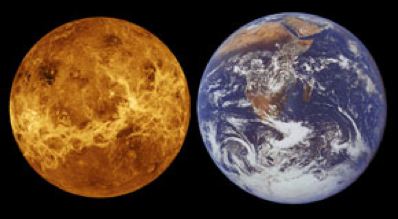
Venus had a wet,
volcanic past
DR EMILY BALDWIN
ASTRONOMY NOW
Posted: JULY 14, 2009


Covered in oceans, continents and flowing lava, Venus may have once been more like Earth's twin than its evil step-sister, say planetary scientists.
Venus is sometimes nicknamed Earth's twin because the two planets share a similar size, gravity and bulk composition. But with a thick cloak of sulphuric acid clouds and a surface pressure nearly one hundred times that of Earth, it is far from hospitable. Planetary scientists believe that a young Venus once possessed Earth-like oceans, which evaporated into space to leave a barren landscape.
 Earth and Venus are similar in size, but appearances can be deceiving. Image: NASA/JPL.
Earth and Venus are similar in size, but appearances can be deceiving. Image: NASA/JPL.
Thanks to ESA's Venus Express satellite, the first map charting the planet's southern hemisphere at infrared wavelengths, and comprising over one thousand individual images, gives scientists another tool in the quest to understand how the two planets evolved so differently.
Radar has been used in the past to penetrate Venus's thick cloud cover that prevents visual observations of the surface, but the new Venus Express map is the first to hint at the chemical composition of the rocks. The data suggest that the highland plateaus are ancient continents created by volcanic activity and were once surrounded by oceans.
"This is not proof, but it is consistent," says Nils Müller at the Joint Planetary Interior Physics Research Group of the University Münster and DLR Berlin, who headed the mapping efforts. "All we can really say at the moment is that the plateau rocks look different from elsewhere."
The Visible and Infrared Thermal Imaging Spectrometer (VIRTIS) onboard Venus Express measured the difference in emissivity – the amount of absorbed infrared energy radiated into space – of different types of rocks, during night-time flybys of the planet's southern hemisphere. These observations, conducted at a wavelength of one millimetre, are very sensitive to temperature and can be used to identify the compositions of different rocks. In all images variations of just three to twenty degrees Celsius were noted, instead of the large temperature difference expected from active lava flows.
 The first temperature map of the planet's southern hemisphere at infrared wavelengths. The map is centred at the south pole and the temperatures range from 442°C (red) to 422°C (blue). The temperature difference is key to understanding whether Venus is volcanically active today. Image: ESA/VIRTIS/INAF-IASF/Obs. de Paris-LESIA.
The first temperature map of the planet's southern hemisphere at infrared wavelengths. The map is centred at the south pole and the temperatures range from 442°C (red) to 422°C (blue). The temperature difference is key to understanding whether Venus is volcanically active today. Image: ESA/VIRTIS/INAF-IASF/Obs. de Paris-LESIA.
"Venus is a big planet, being heated by radioactive elements in its interior," says Müller. "It should have as much volcanic activity as Earth." Indeed, some areas do appear to be composed of darker rock, which hints at relatively recent volcanic flows.
Both Russia and America sent probes to Venus during the 1970s and 80s – Venera and Pioneer, respectively – that sampled rocks made of basalt. Basalt is formed from cooling lava erupted by volcanoes, and, as is the case on Earth, where magma up-wells along ocean ridges to make new oceanic crust.
In contrast, the new map of Venus reveals lighter coloured and older rocks with characteristics similar to Earth's granitic continents. Granite is created when basaltic rocks are forced down into the fiery interior of the planet by the process of plate tectonics, which builds and destroys the Earth's crust in an endless cycle. Water combines with the basalt to form granite and the mixture is reborn through volcanic eruptions.
"If there is granite on Venus, there must have been an ocean and plate tectonics in the past," says Müller. Conclusive evidence, however, will only come from sending a lander to the highland plateaus to directly sample the composition of the rocks there.
The results are reported in the Journal of Geophysical Research.
|



